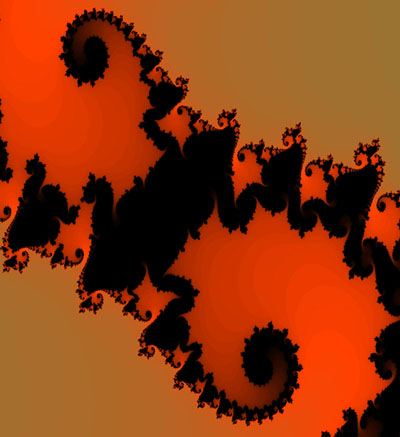Bottom Line: If you don't care about group algebras, it doesn't matter, the mappings are stunning expansions of the Mandelbrot set. Images are generated by making a slice through two of the many dimensions To see the amazing pictures, click on a group at the side-bar and then click any image in the index to see a larger 800x900 pixel size version.
The famous Mandelbrot set is a recursive mapping in two dimensions. The
basic formula is
c n+1 = c n2+ c, where c is
a complex number. The formula is applied to get a new complex number
cn+1 from the complex number cn this formula is
iterated hundreds to thousands of times and the results plotted in a two dimensional map. See
http://www.ddewey.net/mandelbrot/
for details. This process is sometimes more generally called a "recursive mapping".
 This web-site studies recursive mappings of Group Algebras. In this
case, a complex number is replaced by an even more complex algebraic element
that can have many more dimensions than just the two of the complex number.
However the iteration formula is the same and given by the formula at the
upper left corner of this page. Complex "c" is replaced by the group element "g".
You can't see or imagine an image of high dimensions, so the two-dimensional images
shown here are cross-sections or slices through the higher dimensional space - similar
to cutting a 3-dimensional apple to reveal a two dimensional cross-section of the core.
This web-site studies recursive mappings of Group Algebras. In this
case, a complex number is replaced by an even more complex algebraic element
that can have many more dimensions than just the two of the complex number.
However the iteration formula is the same and given by the formula at the
upper left corner of this page. Complex "c" is replaced by the group element "g".
You can't see or imagine an image of high dimensions, so the two-dimensional images
shown here are cross-sections or slices through the higher dimensional space - similar
to cutting a 3-dimensional apple to reveal a two dimensional cross-section of the core.
Technical notes:
There are infinitely many group algebras, but only a dozen or so of
the smaller ones are shown here. The mappings are sorted by the number of
dimensions of the space and by the type of algebra used. These images
range from soft and delicate pastels to rugged bizarre landscapes. Since mappings of
group algebras, occur in higher dimensions, there are many possible axes
for slicing cross-sections.
The first image shown on each page is a matrix of "Dimension Slices". Various slices are planes that go through each pair of dimensions and intersect the origin (except the unit element dimension which is offset by -0.5). In an 8 dimensional space, for example, there are 28 unique ways of slicing the image along the various dimensional axes. There is a redundancy in that dimensions q,r and r,q are both shown, but are simply reflections of each other. Thus the upper diagonal is an equivalent reflection of the lower diagonal. There are other redundancies in that group symmetries give rise to some cross-sections looking the same as others.
There was no attempt to specially color an image; all images use the same color table. The images displayed here are chosen mostly to illustrate similarities or differences from the Mandelbrot set, and not so much for asthetics. Generally the most unusual or alien looking images are displayed here.
Computations were done on an AMD Athlon dual core 64 bit 2.6 GHz processor. The software is written in Java where the computations are double precision (64 bit) floating point. The sustained floating point throughput rate is an amazing 2 GHz - almost at the clock rate of the processors.
The following example is the inner loop for the octonion map:
for (kk = 0; kk < loops; kk++) {
e0=E[0]; e1=E[1]; e2=E[2]; e3=E[3]; e4=E[4]; e5=E[5]; e6=E[6]; e7=E[7];
E[0] = point[0] + e0*e0 - e1*e1 - e2*e2 - e3*e3 - e4*e4 - e5*e5 - e6*e6 - e7*e7;
E[1] = point[1] - e2*e7 + e3*e5 + e4*e6 + 2.0f*( + e0*e1 );
E[2] = point[2] + e1*e7 + 2.0f*( + e0*e2 + e3*e6 - e4*e5 );
E[3] = point[3] - e1*e5 - e2*e6 - e4*e7 + 2.0f*( + e0*e3 );
E[4] = point[4] + e3*e7 + 2.0f*( + e0*e4 - e1*e6 + e2*e5 );
E[5] = point[5] + e1*e3 + e2*e4 - e6*e7 + 2.0f*( + e0*e5 );
E[6] = point[6] + e5*e7 + 2.0f*( + e0*e6 + e1*e4 - e2*e3 );
E[7] = point[7] - e1*e2 - e3*e4 - e5*e6 + 2.0f*( + e0*e7 );
magn = E[0]*E[0]+E[1]*E[1]+E[2]*E[2]+E[3]*E[3]+E[4]*E[4]+E[5]*E[5]+E[6]*E[6]+E[7]*E[7];
fpCounter++;
if ( magn > escape) break;
}
The octonion is not a group because it violates the associative law. It is called a Loop. Details are at wikipedia. Squaring an octonion only involves binary multiplication so the non-associativity does not matter. Group element operations are done through multiplication tables and terms are simplified after multiplication, so non-commutativity problems are avoided. Quaternion maps are not presented here because they are well studied and can be proven to be simply a rotation about the real axis.
To avoid human error, formulae for the inner loops are computer generated.
A group is defined by using generators for the group, such as the following
for the octonion:
par.rules =
"i^2=~1, j^2=~1, k^2=~1, s^2=~1, ij=k, ik=~j, kj=~i, jk=i, ji=~k, si=~is, ki=j, sj=~js, sk=~ks";
Symbolic manipulation of the generator rules results in a symbolic multiplication table
which is used to generate the recursion formulae.
Further work would be to investigate the effect of group symmetries on the mappings. Are there subspaces completely identical to other subspaces? Are there any relations between subspaces comprised of elements of quotient groups?
Click here to contact me for further information